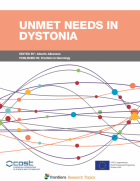
Rapport Annuel COST

Aquatic Primary Biomass Marine Macroalgae

Untersuchengen ûber die behindertengerechte Gestaltung des ôffentlichen schienenverkehrs heft 39 (EN, FR version included)

Investigation on the Feasibility of Biological Control of Pigweeds with Phytophagous Insects, Fungal Pathogens and Crop Management

Transnational Cooperation - Including COST Review

development of Concrete Structures for Desalinatio Plants (CVE-153)

Unmet needs in dystonia
- Author(s): A. Albanese
- Publisher(s): Frontiers Research Topic
- https://www.frontiersin.org/research-topics/4314/unmet-needs-in-dystonia
This Research Topic contains proceedings of the final conference for COST Action BM1101 “Network of dystonia syndromes”. The topic highlights consolidated knowledge and unmet needs in a field that is evolving very fast.

Cyberbulling through the new media
- Pages: 320
- Author(s): Edited by Peter K Smith and Georges Steffgen
- Publisher(s): Psychology Press (Taylor & Francis Group)
- Download from external website
This important new book is the result of a four-year international collaboration, funded by the EU, to better understand how we can cope and confront cyberbullying, and how new media technologies can be used to actually support the victims of such abuse. The articles initially define the historical and theoretical context to cyberbullying, before examining key issues involved in managing this pervasive phenomenon.

Network Coding and Subspace Designs
- Author(s): Greferath, M., Pav?evi?, M.O., Silberstein, N., Vázquez-Castro, M.Á. (Eds.)
- https://www.springer.com/gp/book/9783319702926
This book, written by experts from universities and major research laboratories, addresses the hot topic of network coding, a powerful scheme for information transmission in networks that yields near-optimal throughput. It introduces readers to this striking new approach to network coding, in which the network is not simply viewed as a mechanism for delivering packets, but rather an algebraic structure named the subspace, which these packets span. This leads to a new kind of coding theory, employing what are called subspace codes. The book presents selected, highly relevant advanced research output on: Subspace Codes and Rank Metric Codes; Finite Geometries and Subspace Designs; Application of Network Coding; Codes for Distributed Storage Systems. The outcomes reflect research conducted within the framework of the European COST Action IC1104: Random Network Coding and Designs over GF(q). Taken together, they offer communications engineers, R&D engineers, researchers and graduate students in Mathematics, Computer Science, and Electrical Engineering a comprehensive reference guide to the construction of optimal network codes, as well as efficient encoding and decoding schemes for a given network code.
